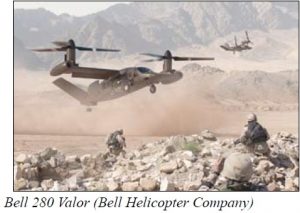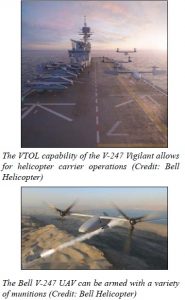by Martin Maisel (photos as credited)
The AW-609
Numerous government and industry studies have indicated that the tilt rotor’s VTOL capabilities coupled with its range and high speed provide a high level of operational and cost effectiveness for many civil and Government applications. With the technological success of the XV-15 and the efficacy of the V-22 program as a foundation, the Bell-Boeing Team began work on a civil tilt rotor aircraft, the BB-609. This aircraft would be a 6- to 9-place, pressurized cabin, executive transport with a VTOL gross weight of about 16,800 lb (nearly 25% heavier than the XV-15) and a maximum speed of 315 mph. When Boeing decided to limit its Bell-Boeing tilt rotor work to military vehicles only, Bell found a new partner, Agusta (an Italian helicopter manufacturer, currently operating as Leonardo), and the aircraft was re-designated the BA-609.
In 2009 Bell elected to withdraw from the -609 development program (but would continue to support certification efforts) and the project was placed under AgustaWestland management.
 While the AW-609 has been undergoing extensive testing to meet FAA and European certification requirements, certification of this new aircraft type presented challenges with the regulatory agencies requiring the aircraft to meet helicopter, fixed wing and new tilt rotor criteria.
While the AW-609 has been undergoing extensive testing to meet FAA and European certification requirements, certification of this new aircraft type presented challenges with the regulatory agencies requiring the aircraft to meet helicopter, fixed wing and new tilt rotor criteria.
On October 30, 2015 one of the prototype AW-609 aircraft crashed during a high-speed test flight, killing two test pilots. The crash investigation identified a fault in the fly-by-wire flight control laws that led to a divergent “Dutch roll” instability and the failure of the aircraft’s tail structure. Design modifications were made and the AW-609 returned to flight-testing in July 2016.
Currently, 60 advanced orders are on the books and AgustaWestland projects a market of 700 aircraft over 20 years. Certification is expected to be awarded in 2017 or 2018 and service entry is planned for early 2019. The AW-609 will be manufactured at AgustaWestland’s plant in Philadelphia, Pennsylvania.
Bell V-280 Valor
Recognizing that the U.S. Army’s rotorcraft fleet was aging and remanufacturing and upgrades of existing helicopters has its limits, the Department of Defense established the Future Vertical Lift (FVL) program to identify rotorcraft that utilizes new technology. The product of the FVL effort would be the identification of a vehicle that provides higher speed, greater range, improved reliability, and is easier and less expensive to maintain and operate than rotorcraft in the current inventory.
 To meet these requirements, Bell Helicopter is proposing a third-generation tilt rotor designated the Bell V-280 Valor. Unlike the XV-15, the V-22 and the AW-609, the Valor wing is not swept forward and only the rotor tilts, not the engine. The aircraft is designed to have a cruise speed of 320 mph (280 knots) and a ferry range of 2,400 miles. Combat range will be 580 to 920 miles.
To meet these requirements, Bell Helicopter is proposing a third-generation tilt rotor designated the Bell V-280 Valor. Unlike the XV-15, the V-22 and the AW-609, the Valor wing is not swept forward and only the rotor tilts, not the engine. The aircraft is designed to have a cruise speed of 320 mph (280 knots) and a ferry range of 2,400 miles. Combat range will be 580 to 920 miles.
Unmanned Aerial Vehicles
Bell Eagle Eye
 In addition to manned aircraft, unmanned tilt rotor aircraft have been studied, intended primarily for military use. The Bell Eagle Eye TR918, developed in the 1990s, was capable of operating from small ships while providing the altitude, range and speed required for surveillance missions. However, since Bell was unable to obtain strong Government interest and funding to further the effort, the Eagle Eye program was discontinued in 2006.
In addition to manned aircraft, unmanned tilt rotor aircraft have been studied, intended primarily for military use. The Bell Eagle Eye TR918, developed in the 1990s, was capable of operating from small ships while providing the altitude, range and speed required for surveillance missions. However, since Bell was unable to obtain strong Government interest and funding to further the effort, the Eagle Eye program was discontinued in 2006.
Bell V-247 Vigilant
 In September 2016 Bell Helicopter revealed the V-247 Vigilant, a new multi-role tilt-rotor unmanned aerial vehicle being developed to meet the future requirements of the US Marine Corps.
In September 2016 Bell Helicopter revealed the V-247 Vigilant, a new multi-role tilt-rotor unmanned aerial vehicle being developed to meet the future requirements of the US Marine Corps.
The V-247 will have a maximum takeoff weight of about 30,000 lbs and would carry up to 13,000 lbs of fuel, armament and sensors. Bell projects that the Vigilant will offer up to 11 hours on station with 600 lbs of payload at a 450 nautical mile mission radius.
If the Marine Corps approves, Bell states that the Vigilant could be in production by 2023.
Outlook
The future of the tilt rotor aircraft remains promising. It appears that military roles for the type are likely to continue to develop. The specialized needs of the military user allow the high costs associated with the power and complexity required to provide vertical lift capability to be accepted. Although studies indicate the potential value of the tilt rotor aircraft, it is not yet known if the demand for a civil VTOL aircraft with the cruise speed and range of a fixed wing executive turboprop airplane will be great enough to justify the initial and operating costs, compared to other vehicle types. We will find out in the next few years.
